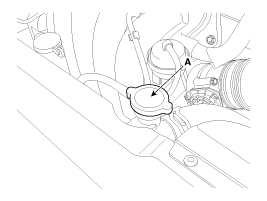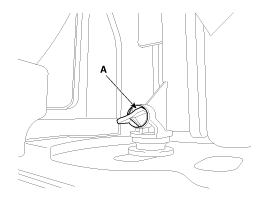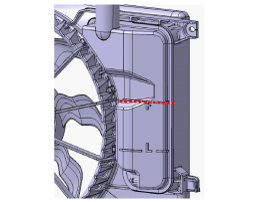 Kia Forte: Coolant Refilling And Bleeding
Kia Forte: Coolant Refilling And Bleeding
Second generation YD (2014-2018) / Kia Forte TD 2014-2018 Service Manual / Engine Mechanical System / Cooling System / Coolant Refilling And Bleeding
Never remove the radiator cap when the engine is hot. Serious
scalding could be caused by hot fluid under high pressure escaping from
the radiator.
|
When pouring engine coolant, be sure to shut the relay box lid
and not to let coolant spill on the electrical parts or the paint. If
any coolant spills, rinse it off immediately.
|
| 1. |
Make sure the engine and radiator are cool to the touch.
|
| 2. |
Remove radiator cap (A).
|
| 3. |
Remove the under cover.
|
| 4. |
Loosen the drain plug (A) and drain the coolant.
|
| 5. |
Tighten the radiator drain plug securely.
|
| 6. |
After draining engine coolant in the reservoir tank, clean the
tank.
|
| 7. |
Fill the radiator with water through the radiator cap and tighten
the cap.
|
| 8. |
Start the engine and allow to come to normal operating temperature.
Wait for the cooling fans to turn on several times. Accelerate the engine
to aid in purging trapped air. Shut engine off.
|
| 9. |
Wait until the engine is cool.
|
| 10. |
Repeat step 1 to 9 until the drained water runs clear.
|
| 11. |
Fill fluid mixture with coolant and water (55~60%) (except for
North America, Europe and China: 45~50%) slowly through the radiator
cap. Push the upper/lower hoses of the radiator so as bleed air easily.
|
| 12. |
Start the engine and run until coolant circulates.When the cooling
fan operates and coolant circulates, refill coolant through the radiator
cap.
|
| 13. |
Repeat step 12 until the cooling fan 3 ~ 5 times and bleed air
sufficiently out of the cooling system.
|
| 14. |
Install the radiator cap and fill the reservoir tank to the "F"
line with coolant.
|
| 15. |
Run the vehicle under idle until the cooling fan operates 2 ~
3 times.
|
| 16. |
Stop the engine and wait coolant gets cool.
|
| 17. |
Repeat step 11 to 16 until the coolant level doesn't fall any
more, bleed air out of the cooling system.
|
 Cooling System
Cooling System
...
 Cooling Fan Components
Cooling Fan Components
1. Cooling fan
2. Fan motor
3. Cooling fan shroud
4. Resister
...
See also:
Components
(1)
[General Type]
(4Door, 2Door)
1. Roof trim assembly
2. Sunvisor [LH]
3. Sunvisor [RH]
4. Retainer
5. Assist handle
6. Assist handle bracket ...
Troubleshooting
Symptom
Suspect area
Engine will not start or hard to start
Vapor hose damaged or disconnected
Engine hard to start
Malfunction of the Purge C ...
Components Location
1. Overdrive Clutch (OD/C)
2. One-Way Clutch (OWC)
3. Low&Reverse Brake (LR/B)
4. Underdrive Brake (UD/B)
5. 26 Brake (26/B)
6. 35R Clutch (35R/C)
7. Damper Clutch ...
Copyright © www.kifomanual.com 2014-2025






